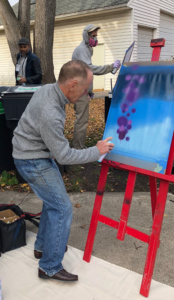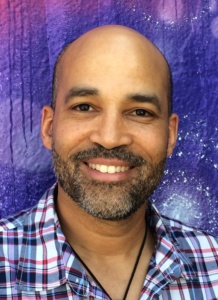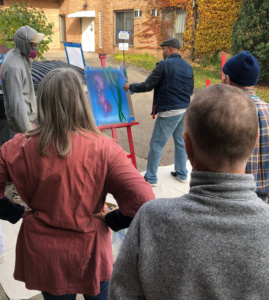The class then moved into collage with colored paper and layering techniques. This is a method I created that helps people think about lettering in different ways by cutting paper into shapes that form the letters of their tag. In some cases, it helps to eliminate the lack of drawing skill because often people can cut a straight line instead of trying to draw one.
Following collage, participants were introduced to aerosol painting. Spray paint is the apex of the graffiti culture [and the medium] by which all graffiti writers and artists are judged. Participants begin with aerosol’s hazy, overspraying, very drippy nature and then slowly learn can control. Can control is introduced as the last part of the instruction because it is the most challenging part and can have discouraging results. Creating sharp clean lines and being able to start and stop the paint intentionally takes years to master. Recognizing that hand/eye coordination, hand/finger pressure, distance, speed, and angle of the can also all play critical rolls in controlling the characteristics of the medium.

After participants had a chance to experiment with their signature, drawing letters, collage, and spray painting, we then tried a group collaboration called, “Graffiti Wall Mash Up,” where participants work together to make create a collaborative mural. This is entirely made up on the spot. The easiest way to approach this is to paint your name — or the name of the represented peer group —in this case it was MIA. “MIA” was painted on three large canvases to create a “Soft Mural.” (Soft Mural is a term I made up in the 1990’s based on the soft sculpture concept by Claes Oldenburg.)
After each segment was introduced the group had an opportunity to discuss, share, and ask questions. Again, for me these were the best parts of the program. Feedback from older adults is something I never get.
Graffiti is an art form created by youth for youth, so getting older adults to participate and talk about their experiences was the highlight for me. And, because half of the class participants were MIA docents, the buzz around the museum spread quickly. It was a huge hit. I feel blessed and grateful for the success of my program and look forward to teaching more with this age group.
Graffiti is an art form created by youth for youth, so getting older adults to participate and talk about their experiences was the highlight for me.
LA: Tell us a short story from the class that demonstrates the benefits of Creative Aging for participants.
PSR: The medium and course I have to offer is unique, especially for older adults. It’s an art form largely produced by young people. Yet, its 50+ year history has allowed it to grow for anyone that has a name and signature and is interested in showing it to the world.
The joy of my course was seeing this group articulate their names, discuss them with each other, and recognize they had something to contribute to the whole group. At one time people were comparing tag styles and joking about placing them around town. During the program’s final reflection, one gentleman said he came into the class very cynical, wondering who could possibly teach a class on graffiti and whether it was going to be some high-class academic that read a book about street art and now going to teach the class? He said he was blown away and that it was truly a master class and one of the best classes he’s ever been in. Everyone just had fun, learned new skills, met new people, learned about a mysterious art form, and left wanting more.
LA: What did you have planned for the culminating event?
PSR: It was a traditional MIA show-and-tell-type of exhibition. Most of the pieces created were on display during an event called 3rd Thursday at MIA. It’s a huge party MIA has every 3rd Thursday of the month. It was well attended with hip hop, DJ’s, food and drink; just a very beautiful event. This was the first of two culminating events. The second will happen in January 2019. I have selected one work from each participant to be framed and hung in the commons area at MIA. This is an exhibition space for their arts’ educational classes.
LA: What are your current and upcoming projects of both your own work and teaching assignments?
PSR: 2019 will be another powerful year for SPRAYFINGER as well as my personal work.
SPRAYFINGER will be teaching at:
- Mississippi Creative Arts Academy in St. Paul in partnership with Interact Center
- Franconia Sculpture Park
- Red Wing Arts Center
- Austin MN Art Center
- Kaleidoscope Charter School
- South High School
Personal exhibitions:
- Submission for an exhibition at Mia MAEP Gallery
- Solo exhibition in May, at Homewood Studios, North Minneapolis
- Josephine Sculpture Park in Frankfort, Kentucky
- Solo exhibition in November at Casket Gallery Factory in Northeast Minneapolis
Facebook: SPRAYFINGER
Instagram: SPRAYFINGER
Instagram: HOUSEOFDASKARONE
Thank you, Peyton!
Check out Peyton’s teaching artist profile, or search our Roster to find qualified teaching artists in your area.
*Peyton’s class with MIA in Minneapolis, MN is part of Aroha Philanthropies’ Seeding Vitality Arts MN initiative.
Interview and reporting by Lindsey Francis.



